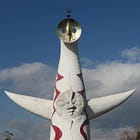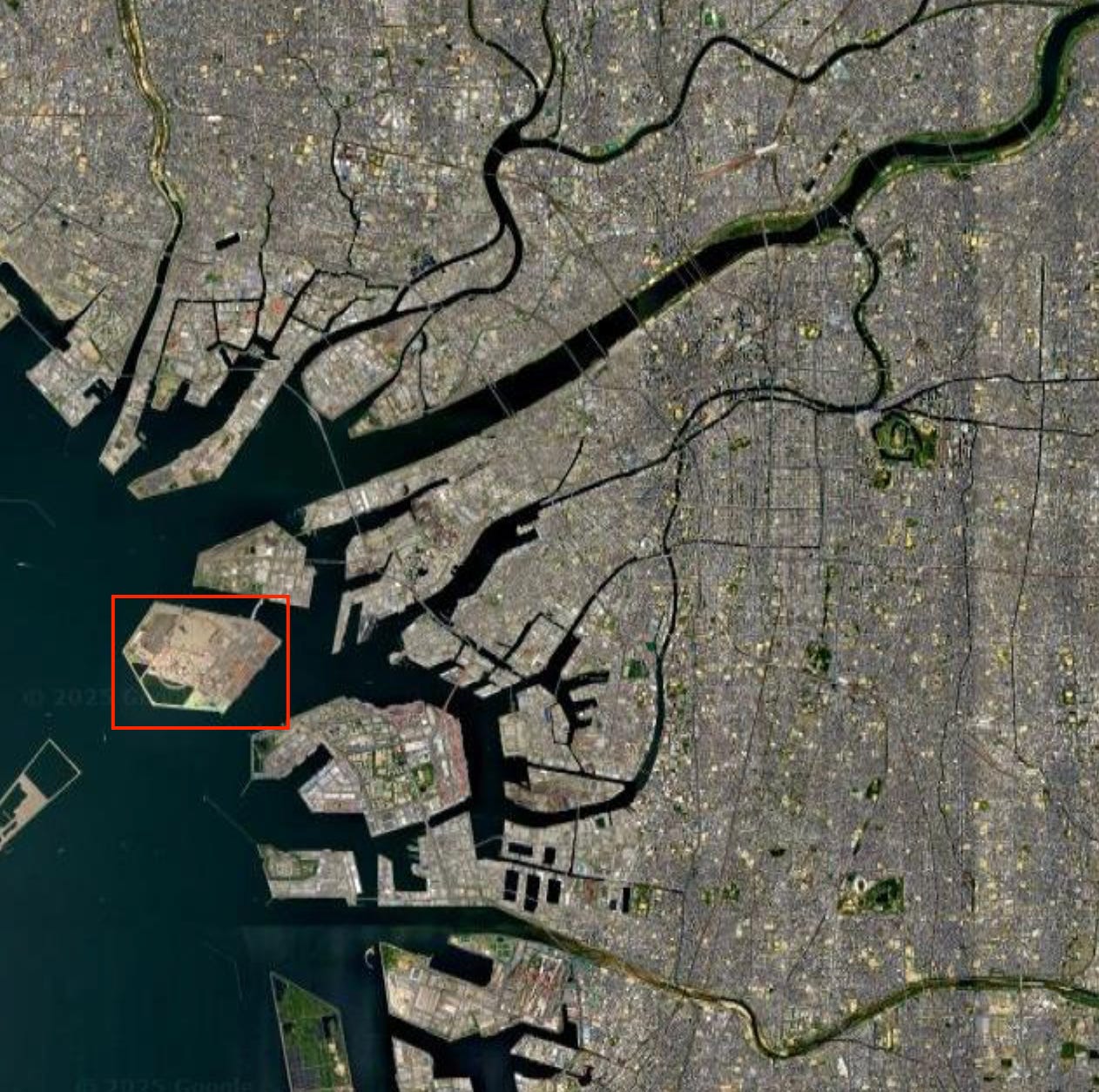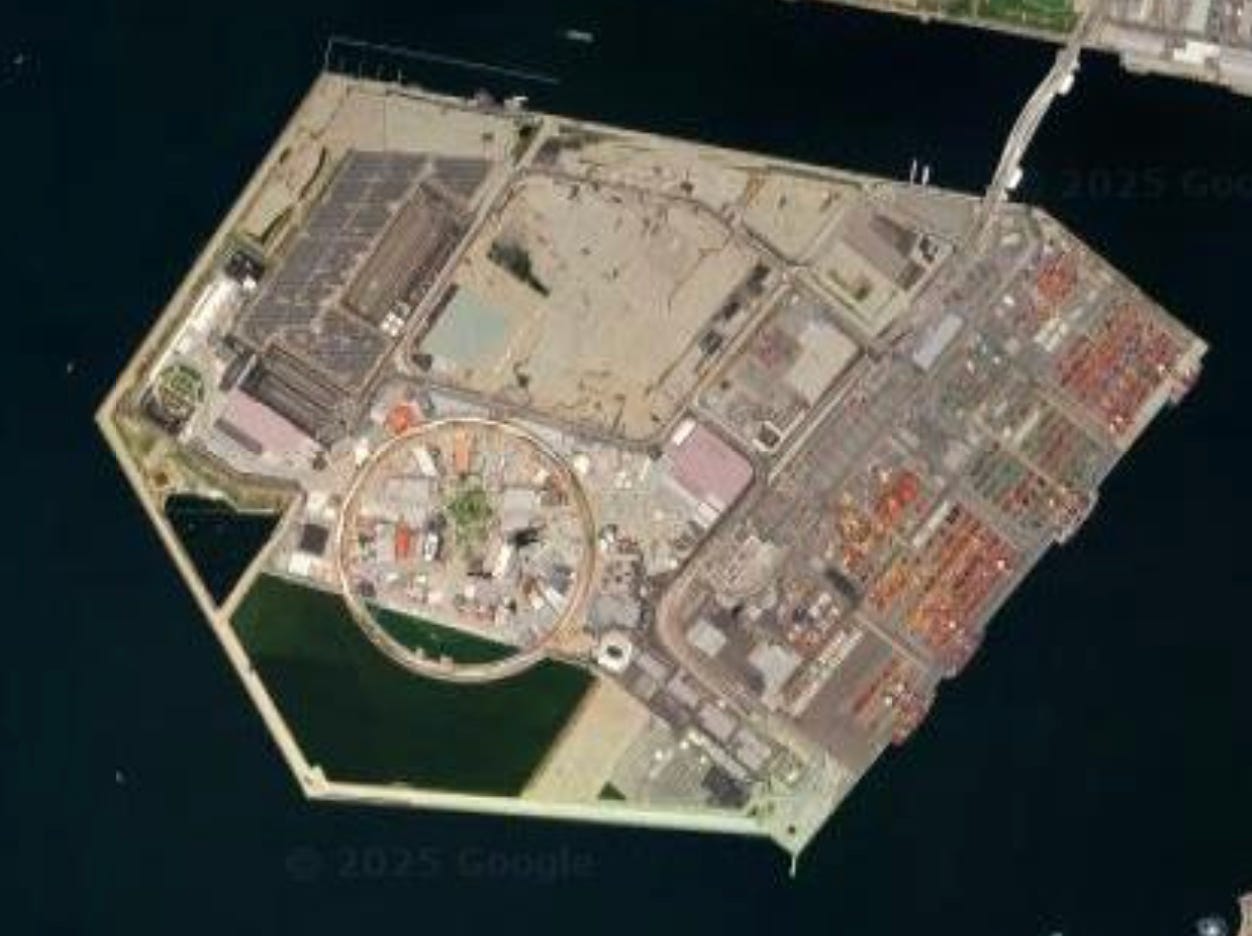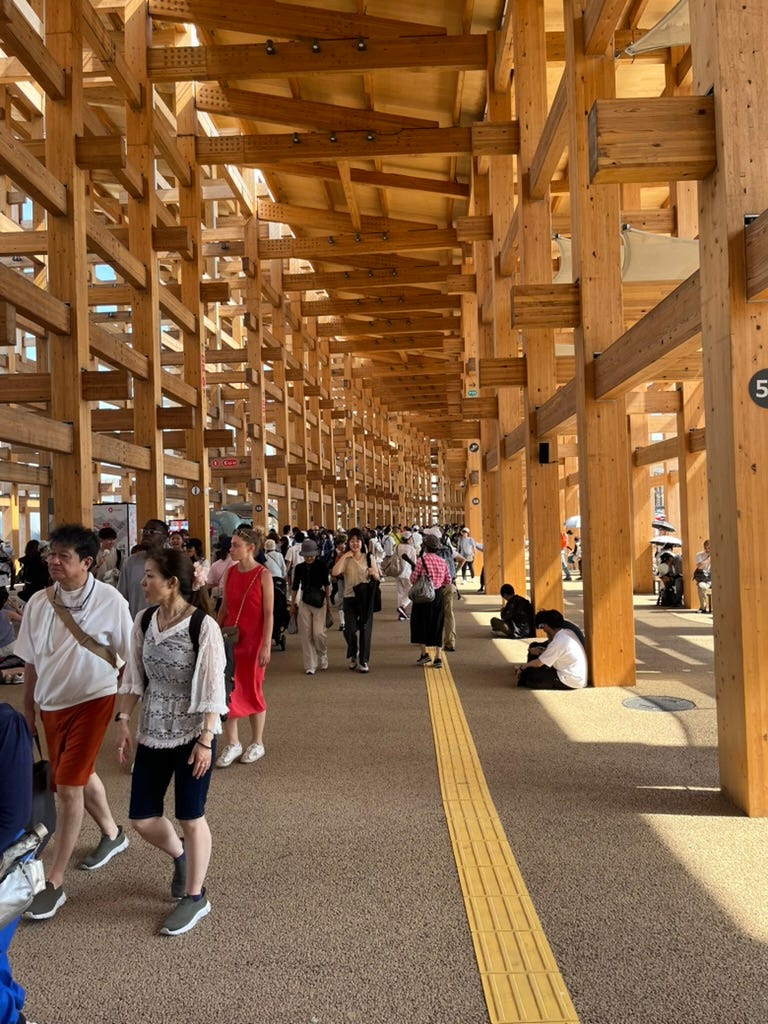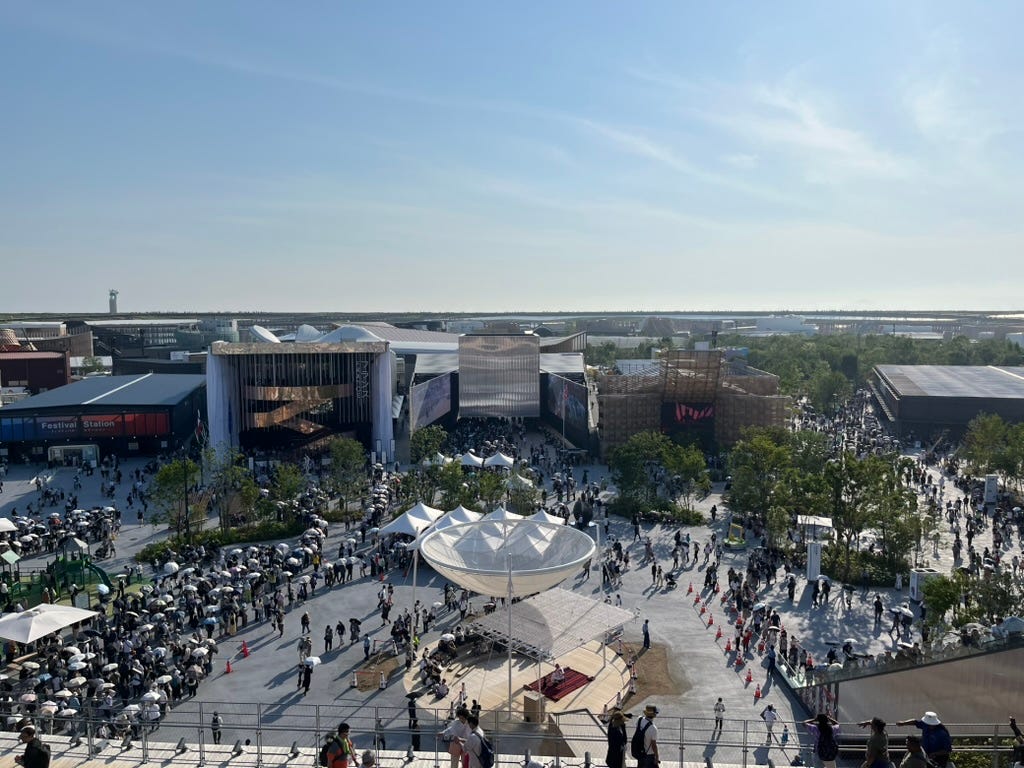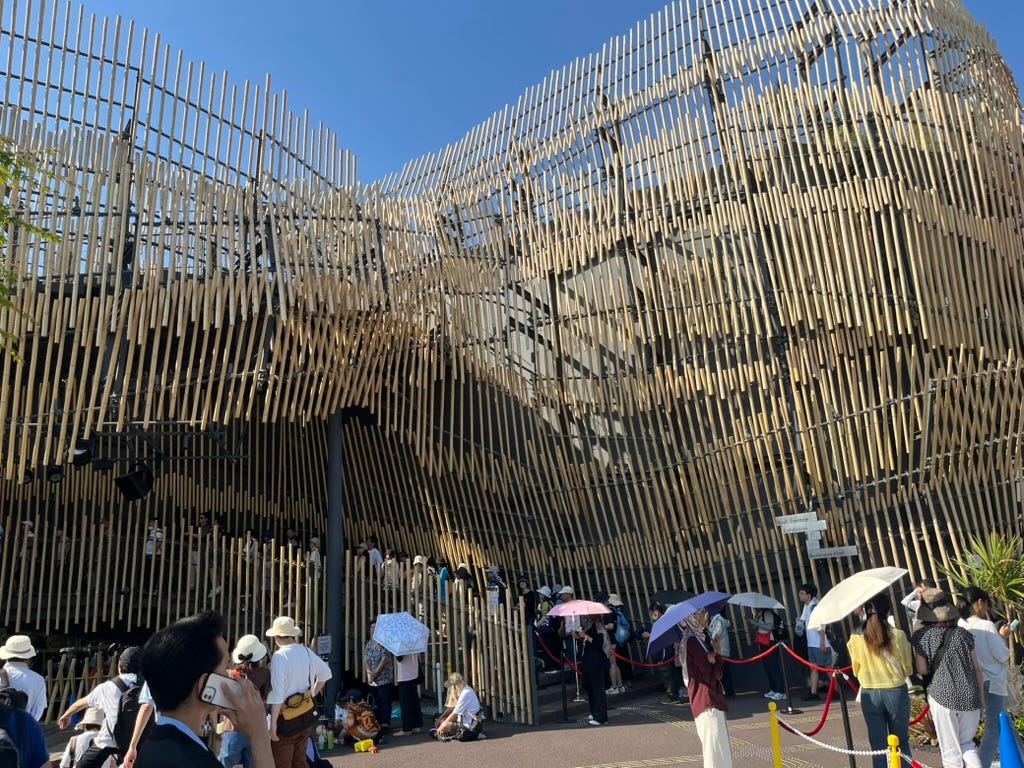For the love of Myaku-Myaku
Part 2 of 2 on expos, on Expo 2025 in Osaka
Short updates:
I recently got a bike seat for the 3-year-old1, took a couple of short trips, then did our first bike-on-the-L trip last weekend. I thought the first step of being able to bike with the kid really expanded the range of where we can go together without a car, but the second step of using trains with the bike REALLY expands the range. I feel like my brain is getting rewired as I think about routes to different places.
It’s only been 2 weeks since the last post so there isn’t that much new, so I’ll highlight a new music festival in Chicago called Sound & Gravity from 9/10 to 9/14. I recognize a lot of the acts, and they’re invariably good. Among them are musicians with Chicago ties, like Third Coast Percussion, Jeremiah Chiu, and Macie Stewart.
Last time, I spent all my time talking about expos/world’s fairs from the past.
This post is all about Expo 2025 in Osaka, which goes until 10/13.
Where is it?
In an echo of the 1939 San Francisco world’s fair in Treasure Island, Expo 2025 is happening on an artificial island in Osaka Bay called Yumeshima, which means Dream Island. Unlike Treasure Island, Yumeshima wasn’t built specifically for the expo, but it was a big container station before, and no one has ever lived there.
I’m sure I’ll talk more about Osaka soon. For now, all I’m going to say is that the big park to the east in the satellite image is where Osaka Castle is, and downtown Osaka is just a little west of that—I know, everything is dense so it’s hard to tell. You can see that Yumeshima (in red) is way off to the west.
If you zoom in, the most prominent thing, by far, is the big circle on the southwest side of the island. I’ll talk about that first.
The Grand Ring
As I wrote last time, past expos have left us with parks, museums, and other famous buildings—I didn’t even mention the most famous one, the Eiffel Tower from the 1889 World’s Fair, for the simple reason that I’ve never been to Paris.
Architecture fans would find a lot of interesting buildings at the expo, but the most impressive structure we saw was the Grand Ring. This is what it looks like from below.
My sister posted a much prettier photo of the ring.
It’s a huge wooden ring that surrounds a big portion of the site. It’s about as tall as a 4-story building, and about 2 km around. It’s apparently the largest wooden structure in the world2. You can walk below it for the shade, which so many people were doing as you can see, or above it for the view.
What’s the expo about?
Expo 2025 does have a theme, “Designing Future Society for Our Lives“, which is…uh…pretty vague. The sub-themes, “Saving Lives”3, “Empowering Lives”, and “Connecting Lives” are just a bit better. There’s definitely too much officialese on the website.4
Having said that, what’s officially the expo’s theme is actually not that important. If you ask a visitor at the expo what the theme of the expo is, they most likely can’t answer.
There are many countries that spent millions of dollars to showcase something about their countries at the expo, and ultimately, that’s because they think it benefits them for a lot of people to see what they’re displaying. They’re hoping more people will visit as tourists, buy products, etc. There’s some element of propaganda here—you are seeing what each country wants you to see about that country.
Many of the “big” countries—the US, China, France, Italy, etc.—have their standalone buildings, or pavilions. Some of them are very popular, and you either need to get a tough reservation or line up for a good amount of time. It’s an amusement park where each attraction is some kind of experience curated by a country.
See the next footnote for things I wanted to see but couldn’t5.
Our strategy
There are well over 100 countries with some sort of an exhibit, and there are some more pavilions from corporations and such. We had some intel from friends and family, but that still only covered a very small fraction of what was there.
So we needed to narrow down what we wanted to see. Here’s some of what we considered:
It was hot and humid most of the time we were in Japan. So no long lines in the sun.
We wanted to see cultures of someone we know, and especially someone that our 3-year-old knows.
I logged into X6 and searched for what people were saying about each pavilion. I wanted to see that people enjoyed going to one, and also that they liked it for the right reasons.
This may surprise my readers, but if people were only talking about the food they got at a pavilion, that was a bad sign for me. A lot of the food on offer wasn’t new to us7, and getting in a long line to order didn’t seem worth it with the kids.We were going to have a stroller, and there were pavilions that prioritized entry for groups with strollers, wheelchairs, etc.
I’m interested in cities, and the 3-year-old is interested in vehicles.
What we saw
The only standalone pavilion we went to was Malaysia, which involved a hack. There was a long line to get in, but because their exhibit starts upstairs, and the only accessible entrance is an elevator, strollers can bypass the line entirely.
And what did Malaysia want us to see? They had a scale model of life in Malaysia that showed both rural life on a farm as well as urban life in apartments with all the vehicles outside. And they have another scale model, of Kuala Lumpur this time, to show you that they really do have a big modern city.
And they have Japanese-style fake food displays for each region’s local dishes. At the end of the exhibit, there’s a food counter where you can get Malaysian food. I would’ve loved some Malaysian food, even if we do have some of it in Chicago, but the line was long.
We also saw the Peru pavilion, which was part of a big building that hosted a few countries. We wanted to go mainly because the 3-year-old has a teacher from Peru.8
Peru showed us an immersive video—they also wanted us to see that they have rural and urban areas, but unlike Malaysia they have deserts. They do offer samples of Peruvian food, but we were unlucky with our timing and couldn’t eat any9. Predictably, they also highlighted their archaeology. When we went, we saw some artifacts associated with the Lord of Sipán, a mummy from the Moche culture. They’re now showing something about the Nazca lines until the expo ends.
One thing that’s really cool is some of the least glamorous part of the expo. There are “Commons” buildings that house many countries under one roof. In the photo from the top of the Grand Ring above, you can see a (very nondescript) Commons building all the way to the right. It’s like a convention center, with booths for dozens of countries. Many of the countries are ones that you may not know much about10, and there’s someone from that country at the booth, ready to answer questions. How often do you get a chance to talk to someone from Yemen and Tonga, minutes apart?
Myaku-Myaku
This is Japan, and everything needs to have a cute mascot. Expo 2025’s official mascot is Myaku-Myaku.

I don’t know what you think, but I love it, and so does the 3-year-old. The best word I heard that describes Myaku-Myaku’s aesthetic is kimo-kawaii, or “creepy cute”. The people who came up with “Designing Future Society for Our Lives” and the person who designed Myaku-Myaku are very different people, and I know who I want to hang out with.
And we got to meet Myaku-Myaku.
What I’m listening to now
This is still 1970s Brazilian music, but so so different from Sérgio Mendes. Azymuth is a Brazilian funk band, and this album is from 1979.
According to Wikipedia, the first track “Jazz Carnival” was a hit in the UK—it’s definitely good, but it’s a long track and probably not to everyone’s taste. The next song, “Partido Alto”, I recommend wholeheartedly. It has an unbalanced beat, with the bass taking center stage most of the time.
My favorite is “Young Embrace (Um Abraço Da Mocidade)”. This song is built on a repetitive melody played on keyboards and a samba rhythm on the percussions. What this reminds me of is the album São Paulo Confessions by Suba. This track wouldn’t sound much out of place in that great electronic album from 20 years later.
At some point I’ll have to figure out an arrangement that can handle both kids, and relatedly, we’re overdue for a bike for Julie.
by building area
One factual error in Ted Gioia’s post that I mentioned last time was that he thought “saving lives” was the whole theme of the expo.
When you look at the Purpose page on their website, one of the goals of Expo 2025 is “to contribute to the achievement of the Sustainable Development Goals (SDGs)”. If you’re not somehow familiar with international development work, you probably don’t know what SDGs are, but for some reason it’s super popular in Japan. I even heard a song about SDGs during a kids’ TV show.
I most wanted to see the Future City Pavilion, for obvious reasons.
Ireland seemed to have nice music performances. You needed to get tickets on site in order to get in.
India, or Bharat, seems to have interesting exhibits. Also, it’s a place that I would love to visit.
Uzbekistan is supposed to be visually spectacular.
China impressed my father-in-law the most. He has a pass to the expo and goes regularly.
Spain has interesting architecture. I also want the “pinchos/tapas from 19 regions” course that they have.
Japanese Twitter users have mostly stayed put, and it’s still probably the best place to get a feel for what a lot of people are saying in Japan.
For example, there were people gushing about poutine. Like, yes, it’s great. I have also had it in Quebec.
We also wanted to see Jordan, where his babysitter is from, but that line was a bit too long.
I think of Peru and Thailand as the 2 most successful countries at food diplomacy.
Here’s the list of countries that were in Commons A, which we went to: Yemen, Uganda, Eswatini, Ghana, North Macedonia, Guinea-Bissau, Kyrgyzstan, Grenada, Kenya, Kosovo, the Comoros, Samoa, Surinam, Sri Lanka, the Seychelles, St. Christopher and Nevis, St. Lucia, Solomon Islands, Trinidad and Tobago, Tonga, Vanuatu, Papua New Guinea, Palau, Barbados, Burundi, Bolivia, Malawi, Mauritius, Rwanda.
